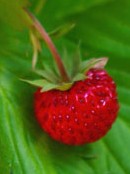 The strawberry of Shakespeare was probably the woodland strawberry (Fragaria vesca), an herbaceous perennial and a member of the rose family (Roseaceae) that can be found in through out most of the Northern Hemisphere growing in forest edges, clearings, pastures, meadows and rocky outcrops. Plants grow two to eight inches high and have palmately compound leaves with three toothed leaflets and round white flowers with five petals the appear continuously from spring until fall. The fruits are less than one half inch long but are strongly flavored and produced from early summer to fall.Woodland strawberries prefer full sun to light shade and moist, well-drained soil but can tolerate clay and very alkaline soils. The are hardy in USDA zones 4-8.
The strawberry of Shakespeare was probably the woodland strawberry (Fragaria vesca), an herbaceous perennial and a member of the rose family (Roseaceae) that can be found in through out most of the Northern Hemisphere growing in forest edges, clearings, pastures, meadows and rocky outcrops. Plants grow two to eight inches high and have palmately compound leaves with three toothed leaflets and round white flowers with five petals the appear continuously from spring until fall. The fruits are less than one half inch long but are strongly flavored and produced from early summer to fall.Woodland strawberries prefer full sun to light shade and moist, well-drained soil but can tolerate clay and very alkaline soils. The are hardy in USDA zones 4-8.
In Othello (act iii, sc. 3, 434) Iago tries to convince the Othello that Desdamona has been unfaithful referring to a handkerchief belonging to her.
Have you not sometimes seen a handkerchief
Spotted with strawberries in your wife’s hand?
In Henry V, (act 1, sc 1, 60) the Bishop of Ely and the Archbishop of Canterbury discuss a bill raised by Parliament that would strip of the Church of its wealth. Ely considers the change in behavior and attitude when he says;
The Strawberry grows underneath the Nettle,
and wholesome berries thrive and ripen best
Neighbor’d by fruit of baser quality;
And so the prince obscured his contemplation
Under the veil of wildness.
Shakespeare has a confident Richard (King Richard III ,act iii, sc. 4, 32) asking for strawberries as he enters his Counsel session:
My lord of Ely, when I was last in Holborn
I saw good strawberries in your garden there;
I do beseech you, send for some of them.
In the same scene a few lines later, Ely notices that Richard (duke of Gloucester) has gone and says;
Where is my lord, the duke of Gloucester?
I have sent for the strawberries.
The consumption of wild strawberries goes back to the Stone Age but they were first cultivated in Persia and later spread via the Silk road to Europe and elsewhere. Our modern day cultivated strawberry is not a descendant of the wild strawberry but was the result of a cross in Brittany France in the 1750s between two American species Fragaria virginiana from eastern North America and Fragaria chiloenis, from Chile. The origin of the common name strawberry is in dispute but is not believed to be related to the mulching of strawberries with straw. The berry part of the name is a misnomer because the part of the plant that we eat is actually the swollen receptacle of the plant and the parts we consider the seeds are actually a kind of fruit called an achene. So, we are actually eating a great many fruits in one bite.